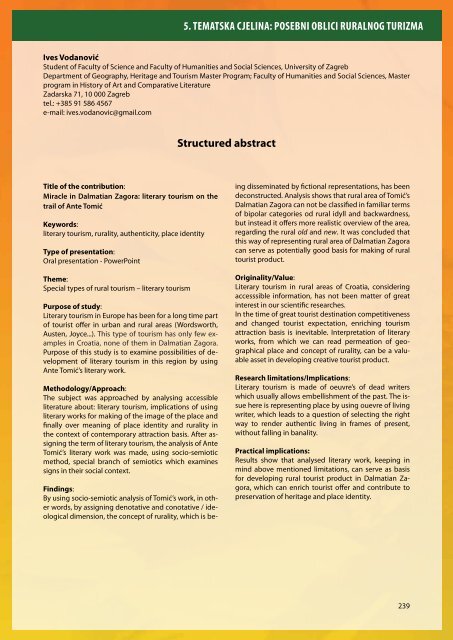KNjIGA SAžETAKA / BOOK Of ABSTRACTS - Treći međunarodni ...
KNjIGA SAžETAKA / BOOK Of ABSTRACTS - Treći međunarodni ...
KNjIGA SAžETAKA / BOOK Of ABSTRACTS - Treći međunarodni ...
You also want an ePaper? Increase the reach of your titles
YUMPU automatically turns print PDFs into web optimized ePapers that Google loves.
Ives Vodanović<br />
Student of Faculty of Science and Faculty of Humanities and Social Sciences, University of Zagreb<br />
Department of Geography, Heritage and Tourism Master Program; Faculty of Humanities and Social Sciences, Master<br />
program in History of Art and Comparative Literature<br />
Zadarska 71, 10 000 Zagreb<br />
tel.: +385 91 586 4567<br />
e-mail: ives.vodanovic@gmail.com<br />
Title of the contribution:<br />
Miracle in Dalmatian Zagora: literary tourism on the<br />
trail of Ante Tomić<br />
Keywords:<br />
literary tourism, rurality, authenticity, place identity<br />
Type of presentation:<br />
Oral presentation - PowerPoint<br />
Theme:<br />
Special types of rural tourism – literary tourism<br />
Purpose of study:<br />
Literary tourism in Europe has been for a long time part<br />
of tourist offer in urban and rural areas (Wordsworth,<br />
Austen, Joyce...). This type of tourism has only few examples<br />
in Croatia, none of them in Dalmatian Zagora.<br />
Purpose of this study is to examine possibilities of development<br />
of literary tourism in this region by using<br />
Ante Tomić’s literary work.<br />
Methodology/Approach:<br />
The subject was approached by analysing accessible<br />
literature about: literary tourism, implications of using<br />
literary works for making of the image of the place and<br />
finally over meaning of place identity and rurality in<br />
the context of contemporary attraction basis. After assigning<br />
the term of literary tourism, the analysis of Ante<br />
Tomić’s literary work was made, using socio-semiotic<br />
method, special branch of semiotics which examines<br />
signs in their social context.<br />
Findings:<br />
By using socio-semiotic analysis of Tomić’s work, in other<br />
words, by assigning denotative and conotative / ideological<br />
dimension, the concept of rurality, which is be-<br />
5. TemATSkA cJelinA: poSeBni oBlici RURAlnog TURizmA<br />
Structured abstract<br />
ing disseminated by fictional representations, has been<br />
deconstructed. Analysis shows that rural area of Tomić’s<br />
Dalmatian Zagora can not be classified in familiar terms<br />
of bipolar categories od rural idyll and backwardness,<br />
but instead it offers more realistic overview of the area,<br />
regarding the rural old and new. It was concluded that<br />
this way of representing rural area of Dalmatian Zagora<br />
can serve as potentially good basis for making of rural<br />
tourist product.<br />
Originality/Value:<br />
Literary tourism in rural areas of Croatia, considering<br />
accesssible information, has not been matter of great<br />
interest in our scientific researches.<br />
In the time of great tourist destination competitiveness<br />
and changed tourist expectation, enriching tourism<br />
attraction basis is inevitable. Interpretation of literary<br />
works, from which we can read permeation of geographical<br />
place and concept of rurality, can be a valuable<br />
asset in developing creative tourist product.<br />
Research limitations/Implications:<br />
Literary tourism is made of oeuvre’s of dead writers<br />
which usually allows embellishment of the past. The issue<br />
here is representing place by using ouevre of living<br />
writer, which leads to a question of selecting the right<br />
way to render authentic living in frames of present,<br />
without falling in banality.<br />
Practical implications:<br />
Results show that analysed literary work, keeping in<br />
mind above mentioned limitations, can serve as basis<br />
for developing rural tourist product in Dalmatian Zagora,<br />
which can enrich tourist offer and contribute to<br />
preservation of heritage and place identity.<br />
239


